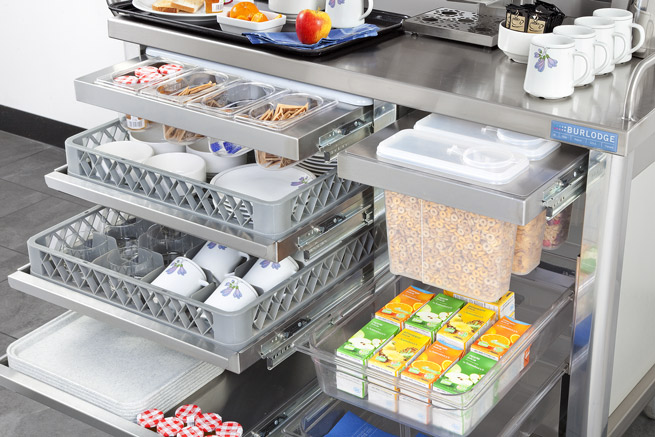Improving Snack and Beverage Delivery in Acute Care
Many factors in hospitals can impact patient satisfaction with food in hospital. In acute care settings, patients can receive a snack during the morning, afternoon and at bedtime (AM, PM, and HS, respectively). Snacks may be given to patients who are sick, underweight or need additional fat and energy in their diet would benefit from having snacks added to their diet, in which case a dietitian would recommend the snack to be delivered to the patient[1]. In addition, patients who do not require consultation with a dietitian may request snacks to be delivered. Currently, snacks are brought up by food services, patient support worker or a volunteer and left at the bedside for the patient. Often, if the patient is not at the bedside due to tests or they are resting beverages or snacks can have uneven temperatures, which drives patient satisfaction down. With a mobile delivery cart dedicated to the AM, PM and HS snack times, hot or cold beverages and snacks can be offered to patients which will increase patient satisfaction, help improve nutrition status and ultimately decrease length of stay in the hospital.
Patient satisfaction with food is associated with several factors such as food temperatures, aroma, presentation, flavour and variety. In addition, patients link food choices and empowerment with overall satisfaction [1]. As a result, hospitals are moving towards a meal delivery system that encompasses the hospitality elements of room service delivery [2-4]. Meals are ordered from a menu, then delivered to the patient via a meal delivery cart. Room service delivery of meals in hospitals has been shown to increase patient satisfaction, improve food and beverage quality, improve timing of snack, reduce food waste and empower the patient with their ability to choose their own food [2]. This system works well for patients on regular, non- therapeutic diets who can execute decision making in food items.
If patient satisfaction can improve with changes in meal delivery, what about snacks and beverage delivery? Food temperatures, quality and visual appeal can decrease over time as snacks are left untouched at the bedside. In addition, patients who need to stay hydrated rely on water at the bedside which can sometimes be unappealing when compared with tea or juice.
One way to enhance patient satisfaction, increase appetite and help improve the nutritional status of patients is to change the way snacks and beverages are delivered to patients between meal times. If snack delivery mimicked what is now being seen in room service type meal delivery, a beverage and snack cart like the Breakfast and Beverage Cart offered from Burlodge would have a food service employee interacting with the patient to offer them a variety of snack and hot or cold beverage options. Employee interaction with the patient can affect the overall hospital experience and impact patient satisfaction[2]. Small changes such as offering warm fresh baked cookies, apple crisp or dinner rolls will help to fill the room with pleasant aromas and create a warm, non-hospital like environment [4]. Burlodge’s Breakfast and Beverage Cart (BBC) is a mobile cart system that has multiple drawers, integrated toast warming cabinet, beverage dispensers and a variety of containers for storage of snack items and it even has an on board boiler to serve hot drinks at the bedside! With a snack and beverage cart, patients are given the unique opportunity to see and smell their snack and beverage options and choose items that they would like to have which will help to decrease complaints and empower the patient with food choices. As one study found, the main advantage of using a hotel style room service option in hospital was increased patient control over their food choices by allowing them to eat what they want and when they want and the same idea can be applied to snacks and beverages served in between meals [3].
In addition to increasing patient satisfaction, a snack a beverage cart offered in between meals will help to meet patient’s nutritional needs and increase hydration. Patients that have orders from the dietitian will receive their specified snack but will also be able to choose from a pre-approved list (that has been reviewed and recommended by the dietitian) of additional snacks and beverages that comply with that patient’s current diet. For several reasons, some patients are unable to meet their fluid needs through water alone and would benefit from having additional options such as milk, juice, coffee or tea offered to them on the cart.
The choice is clear, for improved patient satisfaction and nutritional status it is vital to change the way snacks and beverages are delivered to patients. Visually offering patients snacks and beverage options can help promote appetite, intake, and overall satisfaction. In addition, patients who are able to consume more nutrition, will get better faster and decrease their length of stay in hospital.










